Native name Trieu Au Name Lady Trieu | Died 248 (aged 22–23) | |
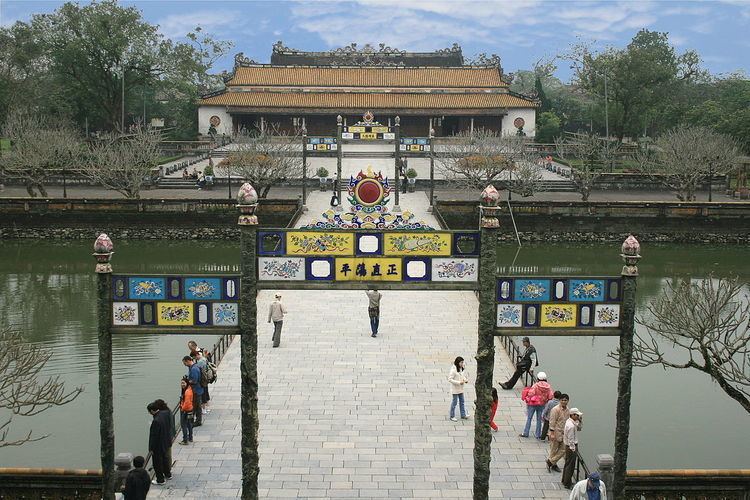 | ||
The legendary lady trieu b tri u
Lady Triệu (Vietnamese: Bà Triệu, Sino-Vietnamese: 趙嫗 Triệu Ẩu; 225–248) was a female warrior in 3rd century Vietnam who managed, for a time, to successfully resist the Chinese state of Eastern Wu during its occupation of Vietnam. She is also called Triệu Thị Trinh, although her actual given name is unknown. She is quoted as saying, "I'd like to ride storms, kill sharks in the open sea, drive out the aggressors, reconquer the country, undo the ties of serfdom, and never bend my back to be the concubine of whatever man." She has also been called the Vietnamese Joan of Arc.
Contents
- The legendary lady trieu b tri u
- Vsa 2014 culture show promo legend of lady tri u
- Names
- Traditional
- Modern
- Other accounts
- Historical differences
- Impact
- References

Vsa 2014 culture show promo legend of lady tri u
Names
In Vietnam, Lady Trieu is most commonly called Bà Triệu, but also Triệu Ẩu (趙嫗), Triệu Trinh Nương (趙貞娘), and Triệu Thị Trinh (趙氏貞). Chinese records do not mention Lady Trieu, the only mention comes in Vietnamese sources. There are two late Vietnamese compilations that mention her by name. One is the official Lê dynasty history, Đại Việt sử ký toàn thư (1479), and other is the official Nguyễn dynasty history, Khâm định Việt sử Thông giám cương mục (1871). Both sources give her name as Triệu Ẩu (趙嫗). This translates to Bà Triệu in modern Vietnamese, and to "Lady Trieu" in English. The given name "Thị Trinh" first appears only in Việt Nam sử lược ("Outline History of Vietnam") (1920) by Trần Trọng Kim. Many cities in Vietnam have a street named Bà Triệu in her honor.
Traditional
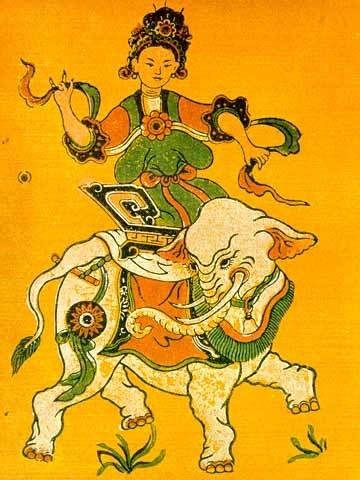
Đại Việt sử ký toàn thư (大越史記全書 Complete annals of Great Viet), written during the Lê dynasty, said the following about Lady Trieu:

The Mậu Thìn year, [248], (11th year of Hán Diên Hy (Han Yanxi (延熙)); 11th year of Xích Ô (Chiwu (赤烏))). The people of Cửu Chân (Jiuzhen (九真)) again attacked citadels, the prefecture was in rebellion. The Wu king appointed the “Hành Dương” Imperial Secretist Lục Dận [Lu Yin] (some books say Lục Thương) to Inspector of Jiaozhou. Dận arrived, used the people's respect for him to call them to lay down arms, people surrendered, numbering more than 30,000 households, and the prefecture was once again peaceful. Afterwards, a woman from the Cửu Chân commandery named Triệu Ẩu assembled people and attacked several commanderies (Ẩu has breasts 3 thước [1.2 m] long, tied them behind her back, often rides elephants to fight). Dận was able to subdue [her]. (Giao Chỉ records only write: In the mountains of Cửu Chân commandery there is a woman with the surname Triệu, with breasts 3 thước long, unmarried, assembled people and robbed the commanderies, usually wearing yellow tunics, feet wearing shoes with curved fronts, and fights while sitting on an elephant's head, becoming an immortal after she dies).
Modern
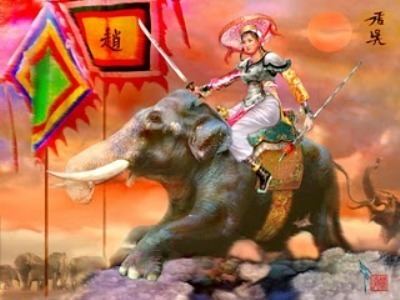
Viet Nam sử lược (A Brief history of Vietnam), a history book that was written in the early 20th century by Vietnamese historian Trần Trọng Kim, said the following about Lady Trieu:
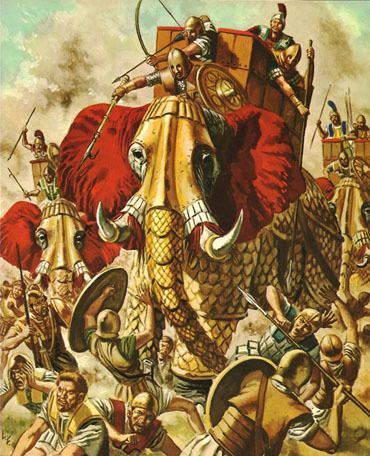
In this year on Cửu Chân prefecture, there was a woman named Triệu Thị Chinh who organized a revolt against the Ngô [Wu].
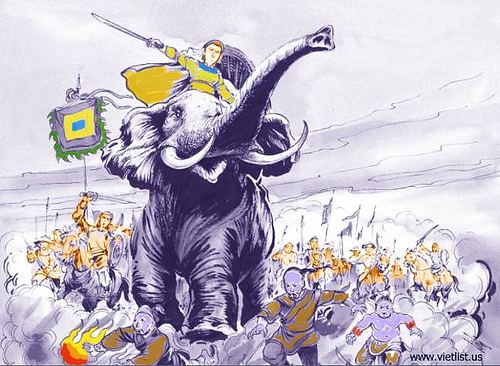
Our [Vietnamese] history recorded that lady Trieu was a people of Nông Cống district. Her parents were dead all when she was a child, she lived with her older brother Trieu Quoc Dat. At the age of 20, while she was living with her sister-in-law who was a cruel woman, she [Trieu Thi Trinh] killed her [sister-in-law] and went to the mountain. She was a strong, brave and smart person. On the mountain, she gathered a band of 1.000 followers. Her brother tried to persuade her from rebelling, she told him: "I only want to ride the wind and walk the waves, slay the big whales of the Eastern sea, clean up frontiers, and save the people from drowning. Why should I imitate others, bow my head, stoop over and be a slave? Why resign myself to menial housework?".
The Mậu Thìn year, [248], because of the cruelty of Ngô [Wu] mandarins and misery of people, Trieu Quoc Dang revolted in Cửu Chân prefecture. Lady Trieu led her troops joined her brother's rebellion, soldiers of Trieu Quoc Dat made her leader because of her braveness. When she went to battles, she usually wore yellow tunics and rode a war-elephant. She proclaimed herself Nhụy Kiều Tướng quân (The Lady General clad in Golden Robe).
Giao Châu Inspector Lục Dận sent troops to fight [her], she [Trieu Thi Trinh] had managed to fight back the Ngô [Wu] forces for 5 or 6 months. Because of the lack of troops and fighting alone, she [Trieu Thi Trinh] could not manage to fight a long war and was defeated. She fled to Bồ Điền commune (present-day Phú Điền commune, Mỹ Hóa district) and then committed suicide.
Later, the Nam Đế (Southern Emperor) of Early Lý dynasty praised her as a brave and loyal person and ordered [his followers] build her a temple, and gave her the title of "Bật chính anh hùng tài trinh nhất phu nhân" (Most Noble, Heroic and Virgin Lady). Present day in Phú Điền commune, in the Thanh Hóa province there is a temple [for her].
Other accounts
In the book Vietnamese Tradition on Trial, 1920-1945 written by David G. Marr, an American Professor, told the story of Trieu Thi Trinh as follow: Trieu Thi Trinh was a 9-foot-tall (2.7 m) woman who had 3-foot-long (0.91 m) breasts. She also had a voice which sounded like a temple bell, and she could eat many rice pecks and walk 500 leagues per day. Moreover, Trinh had a beauty that could shake any man's soul. Because of repeated altercations, she killed her sister and went to a forest in which she gathered a small army and attacked the Chinese. When her brother tried to persuade her from rebelling, she told him:
I only want to ride the wind and walk the waves, slay the big whales of the Eastern sea, clean up frontiers, and save the people from drowning. Why should I imitate others, bow my head, stoop over and be a slave? Why resign myself to menial housework?
After hearing Trinh's words, her brother decided to join her. At first the Chinese underestimated Trinh for her being a female leader but after some encounters, they feared her because of her gaze. Three centuries later, she still offered spiritual support for male Vietnamese opponent of the Chinese. In the Lý dynasty she was honored by the court with a lot of posthumous titles. During the Lê dynasty, Neo-Confucianism became Vietnam's national ideology and many scholars aggressively tried to bring the practices of Trieu Thi Trinh into conformity with Neo-Confucianism. Nevertheless, she survived all their manipulations.
Historical differences
Chinese records make no mention of Trieu Thi Trinh. All available information comes solely from Vietnamese sources that were written during or after the late Ming dynasty. However, the Sanguozhi (Records of the Three Kingdoms), a classical Chinese historical account, does mention a rebellion at this time in the commanderies of Jiaozhi (交趾; Vietnamese: Giao Chỉ) and Jiuzhen (九真, Vietnamese: Cửu Chân):
“In the 11th year of Chiwu (赤烏) [248] in Jiaozhi (交趾), Jiuzhen (九真) rebels attacked walled cities which caused a great uproar. Lu Yin (陸胤) [of Hengyang (衡陽) ] was given rank of the Inspector of Jiaozhou by the Sovereign of Wu. He took his troops and entered the southern border and sent word to the rebels. He used his craftiness to convince them to accept his terms. [In] Gao Liang (高涼), the commander Huang Wu (黄吳) with 3,000 households came out to surrender. Lu Yin now led the army south to that region. He announced his sincerity [to the aborigines] and distributed gifts. The [remaining] 100 rebel leaders and 50,000 households, who had been unruly and unapproachable, kowtowed [to Lu Yin]. Thus the territory was handed over peacefully. At once Lu Yin was given the rank of General who Tranquilizes the South. Again he was sent on a punitive expedition against the rebels in Cang Wu (蒼梧). He defeated them quickly. From start to finish Lu Yin's military troops totaled 8,000. (Later commentaries also cited that Lu Yin then helped to plant crops and kept the people fed.)”
Keith W. Taylor, an American professor, explained these differences as following:
“Chinese records do not mention Lady Trieu; our knowledge of her comes only from Vietnamese sources. From this it is evident that the events of 248 were remembered differently by the two sides. The Chinese only recorded their success in buying off certain rebel leaders with bribes and promises. The resistance led by Lady Trieu was for them simply a kind of stubborn barbarism that was wiped out as a matter of course and was of no historical interest. On the other hand, the Vietnamese remembered Lady Trieu's uprising as the most important event of the time. Her leadership appealed to strong popular instincts. The traditional image of her as a remarkable yet human leader, throwing her yard-long breasts over her shoulders when going into battle astride an elephant, has been handed down from generation to generation. After Lady Trieu's death, her spirit was worshipped by the Vietnamese. We owe our knowledge of her to the fact that she was remembered by the people.”
Impact
Triệu Thị Trinh is a greatly celebrated hero and many streets are named after her in Vietnamese cities (there are Bà Triệu streets in Huế, Hà Nội, Ho Chi Minh City, and several other cities).
